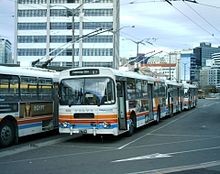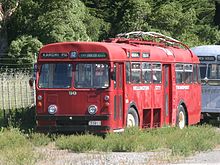
A trolleybus is an electric bus that draws power from dual overhead wires using spring-loaded trolley poles. Two wires, and two trolley poles, are required to complete the electrical circuit. This differs from a tram or streetcar, which normally uses the track as the return path, needing only one wire and one pole. They are also distinct from other kinds of electric buses, which usually rely on batteries. Power is most commonly supplied as 600-volt direct current, but there are exceptions.

The Hamilton Street Railway commonly known as the HSR is a public transport agency in Hamilton, Ontario, Canada. The name is a legacy of the company's early period, when public transit in Hamilton was primarily served by streetcars. Although streetcars are no longer used in the city today, the HSR operates bus and paratransit services, with a ridership of 21 million passengers a year. The HSR uses the Presto card as its method of fare payment, allowing for connections with GO Transit and other transit systems in the Greater Toronto area.

The Boston-area trolleybussystem formed part of the public transportation network serving Greater Boston in the U.S. state of Massachusetts. It opened on April 11, 1936, with a large network operating for the next quarter-century. Measured by fleet size, the Boston-area system was the third-largest trolleybus system in the United States at its peak, with only the Chicago and Atlanta systems having more trolleybuses than Boston's 463. After 1963, the only remaining portion was a four-route cluster operating from the Harvard bus tunnel at Harvard station, running through Cambridge, Belmont, and Watertown. The Massachusetts Bay Transportation Authority took over the routes in 1964.
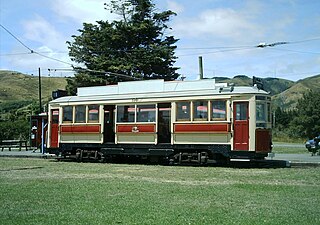
The Wellington tramway system (1878–1964) operated in Wellington, the capital of New Zealand. The tramways were originally owned by a private company, but were purchased by the city and formed a major part of the city's transport system.

NZ Bus is New Zealand's largest bus company, operating in Auckland, Tauranga and Wellington. Formerly a subsidiary of Stagecoach Group and later Infratil and Next Capital, it is now owned by Kinetic Group.
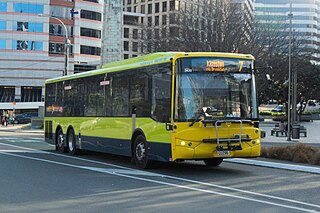
The Wellington Region has a well developed public transport system, the most used in New Zealand. It consists of electric and diesel buses, commuter trains, ferries and a funicular. It also included trams until 1964 and trolleybuses until 2017.
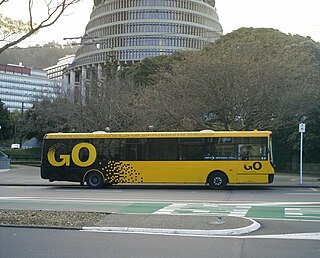
GO Wellington was the brand name of Wellington City Transport Ltd, the Wellington subsidiary of NZ Bus, in New Zealand. The company was branded Stagecoach Wellington by its previous owner, the Stagecoach Group. The current name and a new livery were announced in November 2006 by NZ Bus owner Infratil.
This list collects the transport-related vehicles exhibited or owned by the Museum of Transport and Technology (MOTAT) in Auckland, New Zealand.

The Vancouver trolley bus system forms part of the TransLink public transport network serving Metro Vancouver in the Canadian province of British Columbia. Opened in 1948, the system was originally owned and operated by the British Columbia Electric Railway. By 1954, Vancouver had the largest trolley bus fleet in Canada, with 327 units, and the fleet grew to an all-time peak of 352 in early 1957. There were 19 routes by 1955 and a peak of 20 by the second quarter of 1957. The last route to open in the 1950s was the only express trolley bus service that ever existed in Canada. Several, mostly short, extensions to the system were constructed in the 1980s and later.

The San Francisco trolleybus system forms part of the public transportation network serving San Francisco, in the state of California, United States. Opened on October 6, 1935, it presently comprises 15 lines, and is operated by the San Francisco Municipal Railway, commonly known as Muni, with around 300 trolleybuses. In San Francisco, these vehicles are also known as "trolley coaches", a term that was the most common name for trolleybuses in the United States in the middle decades of the 20th century. In 2022, the system had a ridership of 33,664,000, or about 116,000 per weekday as of the first quarter of 2023.

The Seattle trolleybus system forms part of the public transportation network in the city of Seattle, Washington, operated by King County Metro. Originally opened on April 28, 1940, the network consists of 15 routes, with 174 trolleybuses operating on 68 miles (109 km) of two-way parallel overhead lines. As of the first quarter of 2023, the system carries riders on an average of 37,800 trips per weekday, comprising about 18 percent of King County Metro's total daily ridership. At present in Seattle, a very common alternative term for trolleybus is trolley.

The Santos trolleybus system forms part of the public transport network in Santos, a municipality in the state of São Paulo, Brazil. Opened on 12 August 1963, it presently comprises only one line, and, along with the two São Paulo metropolitan area trolleybus systems, is one of only three trolleybus systems still operating in Brazil.

The Philadelphia trolleybus system forms part of the public transportation network serving Philadelphia, in the state of Pennsylvania, United States. It opened on October 14, 1923, and is now the second-longest-lived trolleybus system in the world. One of only five such systems currently operating in the U.S., it presently comprises three lines, and is operated by the Southeastern Pennsylvania Transportation Authority (SEPTA), with a fleet of 38 trolleybuses, or trackless trolleys as SEPTA calls them. The three surviving routes serve North and Northeast Philadelphia and connect with SEPTA's Market–Frankford rapid transit line.

The Fribourg trolleybus system forms part of the public transport network in Fribourg, capital of the canton of Fribourg, Switzerland. The system also serves the neighbouring municipalities of Villars-sur-Glâne and Givisiez, using one line in each case.

The La Chaux-de-Fonds trolleybus system forms part of the public transport network in La Chaux-de-Fonds, in the canton of Neuchâtel, Switzerland.

The Singapore trolleybus system formed part of the transportation network of Singapore from 1926 to 1962. The system was constructed between 1926 and 1927 as a replacement to the Singapore tramway network with the old tram routes converted to trolleybus routes. The network became one of the world's largest in the 1930s, with a total network length of 24.96 miles (40.17 km) and fleet of 108 trolleybuses.
As of 2012 there were around 300 cities or metropolitan areas where trolleybuses were operated, and more than 500 additional trolleybus systems have existed in the past. For complete lists of trolleybus systems by location, with dates of opening and closure, see List of trolleybus systems and the related lists indexed there.

The Montreux/Vevey trolleybus system, also known as the Vevey–Villeneuve trolleybus line, forms part of the public transport network in Montreux and Vevey, in the canton of Vaud, Switzerland. It comprises a single 12.75 km (7.92 mi) long trolleybus route along the length of the Riviera vaudoise on the north shore of Lake Geneva.

Trolleybuses in Auckland were part of the Auckland public transport system from 1938 until 1980.





